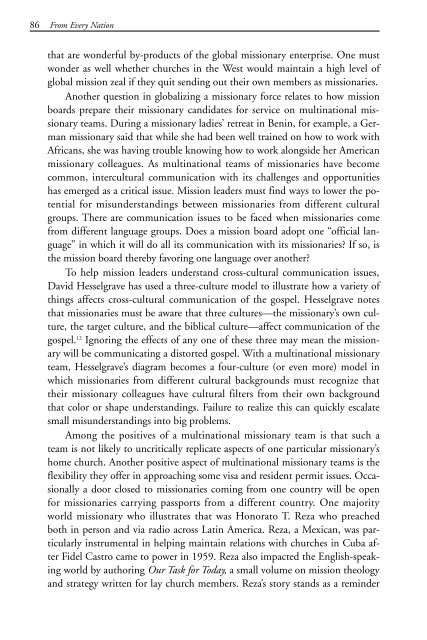discovering missions - Southern Nazarene University
discovering missions - Southern Nazarene University
discovering missions - Southern Nazarene University
You also want an ePaper? Increase the reach of your titles
YUMPU automatically turns print PDFs into web optimized ePapers that Google loves.
245187 Disc Missions ins 9/6/07 1:04 PM Page 86<br />
86 From Every Nation<br />
that are wonderful by-products of the global missionary enterprise. One must<br />
wonder as well whether churches in the West would maintain a high level of<br />
global mission zeal if they quit sending out their own members as missionaries.<br />
Another question in globalizing a missionary force relates to how mission<br />
boards prepare their missionary candidates for service on multinational missionary<br />
teams. During a missionary ladies’ retreat in Benin, for example, a German<br />
missionary said that while she had been well trained on how to work with<br />
Africans, she was having trouble knowing how to work alongside her American<br />
missionary colleagues. As multinational teams of missionaries have become<br />
common, intercultural communication with its challenges and opportunities<br />
has emerged as a critical issue. Mission leaders must find ways to lower the potential<br />
for misunderstandings between missionaries from different cultural<br />
groups. There are communication issues to be faced when missionaries come<br />
from different language groups. Does a mission board adopt one “official language”<br />
in which it will do all its communication with its missionaries? If so, is<br />
the mission board thereby favoring one language over another?<br />
To help mission leaders understand cross-cultural communication issues,<br />
David Hesselgrave has used a three-culture model to illustrate how a variety of<br />
things affects cross-cultural communication of the gospel. Hesselgrave notes<br />
that missionaries must be aware that three cultures—the missionary’s own culture,<br />
the target culture, and the biblical culture—affect communication of the<br />
gospel. 12 Ignoring the effects of any one of these three may mean the missionary<br />
will be communicating a distorted gospel. With a multinational missionary<br />
team, Hesselgrave’s diagram becomes a four-culture (or even more) model in<br />
which missionaries from different cultural backgrounds must recognize that<br />
their missionary colleagues have cultural filters from their own background<br />
that color or shape understandings. Failure to realize this can quickly escalate<br />
small misunderstandings into big problems.<br />
Among the positives of a multinational missionary team is that such a<br />
team is not likely to uncritically replicate aspects of one particular missionary’s<br />
home church. Another positive aspect of multinational missionary teams is the<br />
flexibility they offer in approaching some visa and resident permit issues. Occasionally<br />
a door closed to missionaries coming from one country will be open<br />
for missionaries carrying passports from a different country. One majority<br />
world missionary who illustrates that was Honorato T. Reza who preached<br />
both in person and via radio across Latin America. Reza, a Mexican, was particularly<br />
instrumental in helping maintain relations with churches in Cuba after<br />
Fidel Castro came to power in 1959. Reza also impacted the English-speaking<br />
world by authoring Our Task for Today, a small volume on mission theology<br />
and strategy written for lay church members. Reza’s story stands as a reminder

















